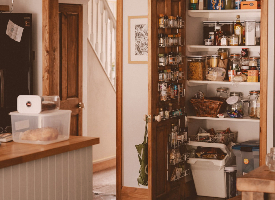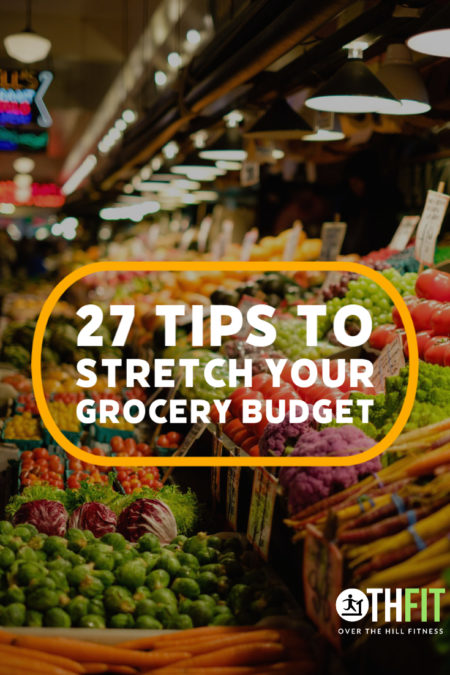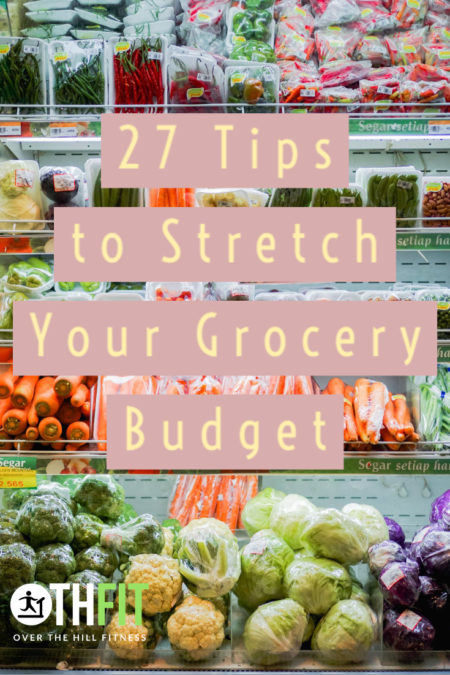
27 Tips to Stretch Your Grocery Budget
I grew up in a way that most of my peers didn’t. My family was large and very poor. We lived in the country and raised most of our own food. We had a large garden, chickens for eggs and meat, hogs that we butchered, and we made almost everything from scratch.
Our heat was a wood-burning stove and the wood came from trees that we cut down and chopped up ourselves. We didn’t have air conditioning but if we were lucky Daddy would be able to rig the ancient water cooler to blow some slightly frosty air into the house.
Shopping for clothes was almost always done at second-hand shops and only if we weren’t able to forage some hand me downs from various relatives. We got a pair of school shoes in the fall, a pair of winter boots, and a pair of flip flops in the summer. We made them last as long as possible by taking very good care of them because we knew we couldn’t afford to replace them.
Growing up this way required a strong work ethic, early mornings, a commitment to making sure chores were always done. We lived 45 minutes away from a real grocery store so if you didn’t thaw meat out for dinner or forgot to start boiling potatoes you couldn’t just run and pick something up. We didn’t have drive through restaurants or even sit down restaurants nearby.

As an adult, the skills that I learned serve me well when times are difficult. The Coronavirus pandemic has kicked my instincts into high gear. It feels like every thing is up in the air and I am compelled to cut back and scrimp and save just to be safe.
I’d like to share with you some of my strategies to save money, stretch a budget, and reduce waste during lean times and hopefully they’ll help you as they’ve helped me through the years.
Clean Out Your Cupboards
Before you can really get started it’s important to know what you have. I recommend doing a thorough cleaning, including pantries, drawers, cabinets, refrigerator, and freezer.
It means a lot of up-front work, especially if you are like me and hold onto things, but you will most likely find things that you had forgotten about. For example, when I cleaned out my kitchen pantry, I found 4 boxes of tea bags for iced tea.
Anything that is expired should be tossed, if you are timing this to coincide with a healthy eating initiative you can also donate anything that doens’t fit in with your goals. I took this time to donate everything that didn’t fit in with my keto way of eating. Since we are in a pandemic, there are a lot of food pantries that really need donations.

*Note if money is very tight and you are worried about feeding yourself and your family, do not concern yourself with whether something fits your macros or not. You can make what you have into healthful meals with ingenuity and there’s no reason to feel badly. You are doing what you need to do to take care of the most important things first.
The Weekly Meal Plan
You’ve already gotten your pantry cleaned out and organized from our first step. That puts you in great shape for what I recommend as a weekly or bi-weekly task, The Meal Plan.
A large part of your savings can come from your grocery shopping. I apply the saying, “The best defense is a good offense” when I tackle my grocery budget. I prepare as much as possible
There are a few steps involved, and again, it is some upfront work, but it will save you money and time because you will be prepared. The steps are:
- Review what supplies you have on hand. Include proteins, veggies, sides, etc.
- Create a weekly or bi-weekly menu. Include all meals and snacks that you will eat at home and any meals and snacks you will provide for school/work. You can use your weekly grocery store ads to see what items are on sale to get ideas for meals/snacks.
- Create a grocery shopping list. Add any items that are needed to fulfill your menu. It also helps to make a list of what you already have on hand for your menu to ensure that you truly have what you believe.
- Use your local grocery store website/apps. You can look for online coupons or savings for the needed items and see which store(s) would be most cost-effective and download any coupons to your account/card if needed.
- Place the grocery order online. This allows you to stick to your list. Also as we are in a pandemic, it keeps you from having to go into a store. Due to the pandemic most stores don’t have additional fees for the pickup option, if you need delivery service, there is typically an additional fee.
Where and How to Buy Groceries & Home Goods
There are some items that you may be used to buying ready to use or in small quantities that you could save quite a bit on by either buying in bulk or doing a bit more work and making it yourself. The following are items that I save money on.
- Trash bags – Costco sells their Kirkland brand 13-gallon trashbags for 15.99 for 200! They are heavy-duty and comparable to the Glad ForceFlex trash bags. One box lasted my family of 3 about a year.
- Toilet paper – This one is more difficult at the moment because of the pandemic but typically if you can buy in bulk you should. I just bought 30 rolls of Charmin at Target for about $30 because that was the biggest package I could find. It seems that toilet paper is once again running low.
- Paper towels – I try to use cloth towels for almost everything but I do use Viva paper towels occasionally and I buy them in bulk when I am able. Again, they are hard to find right now. Viva is the brand my grandmother used and swore by. She would use one paper towel all day rinsing and wringing it out to wash off her small countertop.
- Laundry soap/Fabric softener – There are tons of homemade recipes out there for laundry soap but my research into it and talking to my plumber convinced me that it’s not worth it. It is potentially very harmful to your washing machine. Buying these items in bulk is the way to go.
- Dishwashing pods – This is another item I get from Costco. It’s one that I splurge a bit on because our dishwasher is ancient and I need the best soap. But you can get Finish which I think is just fine if you have a better dishwasher for a much more reasonable price.
- Personal hygiene – Body wash, deodorant, shampoo, and conditioner, handsoap, and toothpaste. All of these can be purchased in bulk, usually in packs of 5 at Costco or Sams. It’s worth it if you can afford the up-front price. If you cannot, dollar stores usually have good name-brands that were overstocked at lower prices, and stores like Walmart have their store brands that are almost always comparable but a fraction of the price.
- Razors – We use the **This is an affiliate link we have been with them for several years and truly love them but we do get a little $ if you end up purchasing from this link.
- Dog food and supplies– We have 4 dogs and 3 of them are large with large appetites so we go through a lot of dog food. Our solution has been Chewy. We are on their autoship so we get a discount each time and we don’t have to worry about going to the store. Every month we get 67 pounds of dog food delivered to our door.
- Tea – I brew our own iced tea using tea bags. We used to buy gallons of iced tea. Now I can buy 100 tea bags for $2-$3 and have enough to make tea for a couple of weeks.
- Processed foods – We don’t buy them. We don’t buy foods that come in boxes or are pre-made. Most of that is due to health concerns but it is also cheaper overall. If my son wants cookies, we can make some with some flour, sugar, salt, vanilla, butter, brown sugar, and eggs. It’s more work than opening a package, but they taste so much better, they use cents worth of ingredients, and he learns good skills.
- Spices – Spices make all of the differences when you are making your own food. I buy a lot of inexpensive cuts of meat, like pork loin, and then use spice to make it exciting. They can be expensive; however. That’s why I don’t purchase them from the supermarket! It is worth a trip to your local Indian market to get spices. I stock up on large bags of Turmeric, ginger, cumin, onion powder, garam masala, and garlic powder and spend less than $15.
Processing Groceries
Once you pick up your groceries or have them delivered there are steps you can immediately take to help extend their freshness and ensure that you will use all of them and not have waste.
- Put groceries away immediately.
- Canned goods and pantry items organized in a visible way. Since you did all of the work to organize your pantry and cabinets, you want to make sure that when you put away your canned goods and non-perishables you do so in a way that they stay organized and easy to see what you have.
- Transfer flours, sugars, & other perishables to storage containers. I haven’t ever had mealworms or moths, but this was something I learned as a child. The paper packaging that those items come in does not keep pests out.
- Process meat into serving sizes and freeze or refrigerate immediately. Most meat will freeze better if you remove it from the store packaging and freeze it in a freezer bag with as much air removed as possible. Freeze it in the serving size that you need.
- Ground meat should be rolled flat to save space and make thawing quicker. Rolling ground meat flat in the freezer bag will allow the bags to stack, saving freezer space and the meat will thaw faster in the refrigerator.
- Fresh produce should be stored correctly and processed as needed. Produce that needs to be refrigerated should be in the crisper drawer; however, I typically remove them from the bags they come in and place them in airtight bags. Fresh herbs I also transfer to airtight bags and I place a dry paper towel to help keep them from getting mushy by absorbing excess moisture unless they are the herbs that come in the little plastic cases.
- Buy cheese in large blocks and process it at once. I buy cheese in the largest blocks I can and immediately shred some of it storing it in an airtight bag, slice some of it into cracker-size slices, and then slice some of it into thinner sandwich-size slices using a cheese plane. I do this right away so that I don’t have a lot of prep work to do during the week before meals or snacks, we are more likely to stick to the menu if it’s easier to do.
- Make sure everything in your refrigerator and freezer is visible and easy to access.
- Post your menu on the refrigerator door or somewhere else highly visible. You are more likely to stick to something that you see each time you go to the kitchen and open the fridge door.
- Complete any meal prep that you need to for the week ahead lay out 2 days of meat in the refrigerator. By keeping 2 days of meat in the fridge you will ensure that you won’t be caught off guard with frozen meat and no dinner at 6 pm on a Wednesday.
That’s it! If you follow these 27 tips to stretch your grocery budget you will find that you are able to use more of your purchased items and your will have less food waste.
Do you have tips you’d like to add? I’d love to hear from you!






One Comment
Katherine
Awesome list! I have recently started doing some of these and this list gives me some more to work on! Thanks!